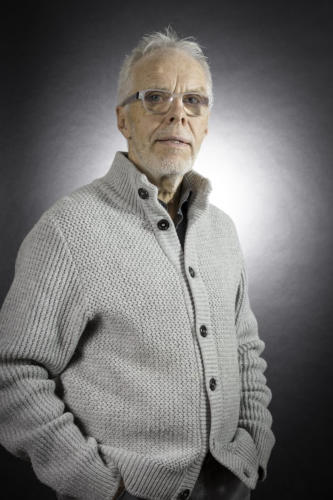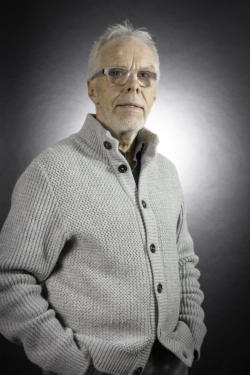A
word,
heard
in
a
dialogue
between
two
fellow
passengers
on
the
train,
half
a
sentence
overheard
in
a
conversation
between
two
neighbours
on
a
park
bench,
a
quotation
from
an interesting book, a concise headline from a newspaper…
Nature
with
its
manifold
patterns,
colours
and
shapes,
the
beauty
of
a
fabric,
social
conditions that need to be questioned, the impact of our wasteful society…
All
of
this
ignites
fantasies,
develops
ideas
for
an
interpretation,
a
transformation,
a
realisation
with
the
creative
artist’s
own
means
of
expression,
through
his
treatment
and
artistic realisation.
Very
interesting
materials
but
little
known
or
even
never
used
in
artistic
creation,
and
certainly
not
in
textile
art,
provoke
the
desire
to
work
them
artistically,
to
transform
them
into
an
art-work.
Some
colours,
street
or
nature
views,
unusual
colour
combinations,
which
can
be
seen
on
the
clothes
of
city
strollers,
a
reflection
on
the
value
and
meaning
of
colour,
awaken
the
need
to
work
with
them.
The
techniques
and
materials
used
for
their
realisation
are
as
varied
and
different
as
the
sources
of
inspiration.
The
digital
world
is
becoming
more
and
more
powerful
and
is
now
occupying
an
increasingly
large
place
among creative techniques.

Textile
art
is
the
desire
and
pleasure
to
realise
and
process
the
most
diverse
materials
in
such
a
way
that
they
delight
in
a
new
aesthetic.
There
is
no
taboo,
not
only
the
entire
range
of
the
textile
spectrum,
even
unprocessed
or
melted
plastics,
are
involved:
Metal,
PET
bottles,
packaging,
felt,
polyethylene
tarpaulins,
bark,
glass
and
more.
Characteristic
for
the
implementation
of
these
materials
are
accuracy
and
precision,
which
requires
an
enormous
amount
of
time
and
patience.
The
art-works
seem
to
be
very
different,
but
they
all
have
a
certain
rigour
in
terms
of
colours
either
very
harmonious
in
the
nuances
of
a
colour
or
in
a
carefully
chosen
contrast
,
but
the
most
important
principle
is
to
please
the
eye,
to
trigger
emotions,
to
keep
the
soul
balanced,
to
relax
and
let
the
viewer
come
to
rest. Faced with the horrors of the world around us, to preserve ourselves, to keep the world and the future healthy and balanced.
After
studying
art
education
(among
other
things)
for
the
teaching
profession
and
studying
fine
arts
at
the
Folkwangschule
Essen,
Dieter
Filler,
who
is
of
German
origin,
sought
his
path
of
creation
under
different
materials
(wood,
clay,
plastic).
At
the
beginning
of
the
90s
he
discovered
in
Switzerland
the
possibilities
of
creating
imaginative
and
creative
paintings
with
materials.
He
attended
courses to learn the traditional techniques developed by the Amish people in the United States.
He
was
limited
by
the
supposedly
limited
possibilities
of
expression,
the
too
strict
rules
of
design
and
the
always
same
material,
so
that
he
developed
a
personal
form
of
implementation.
The
entire
textile
palette
as
well
as
new
materials
and
the
third
dimension
as
surface
relief
were
included.
The
various
courses
attended
over
several
years
in
Ste
Marie
aux
Mines
as
part
of
the
“Carrefour
Européen du Patchwork” have increasingly motivated the development towards “textile art”.
« I always have the feeling that my days are not enough to realise all the ideas, plans and dreams that are going through my mind ».
Dieter Filler.

TEXTILE ART
Conditions générales d’utilisation © Arts Textiles - Tous droits réservés Politique de confidentialité

Dieter Filler
TEXTILE ART
A
word,
heard
in
a
dialogue
between
two
fellow
passengers
on
the
train,
half
a
sentence
overheard
in
a
conversation
between
two
neighbours
on
a
park
bench,
a
quotation
from
an
interesting
book,
a
concise
headline from a newspaper…
Nature
with
its
manifold
patterns,
colours
and
shapes,
the
beauty
of
a
fabric,
social
conditions
that
need
to
be
questioned, the impact of our wasteful society…
All
of
this
ignites
fantasies,
develops
ideas
for
an
interpretation,
a
transformation,
a
realisation
with
the
creative
artist’s
own
means
of
expression,
through
his
treatment and artistic realisation.
Very
interesting
materials
but
little
known
or
even
never
used
in
artistic
creation,
and
certainly
not
in
textile
art,
provoke
the
desire
to
work
them
artistically,
to
transform
them
into
an
art-work.
Some
colours,
street
or
nature
views,
unusual
colour
combinations,
which
can
be
seen
on
the
clothes
of
city
strollers,
a
reflection
on
the
value
and
meaning
of
colour,
awaken
the
need
to
work
with
them.
The
techniques
and
materials
used
for
their
realisation
are
as
varied
and
different
as
the
sources
of
inspiration.
The
digital
world
is
becoming
more
and
more
powerful
and
is
now
occupying
an
increasingly
large
place
among
creative techniques.

Textile
art
is
the
desire
and
pleasure
to
realise
and
process
the
most
diverse
materials
in
such
a
way
that
they delight in a new aesthetic.
There
is
no
taboo,
not
only
the
entire
range
of
the
textile
spectrum,
even
unprocessed
or
melted
plastics,
are
involved:
Metal,
PET
bottles,
packaging,
felt,
polyethylene
tarpaulins,
bark,
glass
and
more.
Characteristic
for
the
implementation
of
these
materials
are
accuracy
and
precision,
which
requires
an
enormous
amount
of
time
and
patience.
The
art-
works
seem
to
be
very
different,
but
they
all
have
a
certain
rigour
in
terms
of
colours
either
very
harmonious
in
the
nuances
of
a
colour
or
in
a
carefully
chosen
contrast
,
but
the
most
important
principle
is
to
please
the
eye,
to
trigger
emotions,
to
keep
the
soul
balanced,
to
relax
and
let
the
viewer
come
to
rest.
Faced
with
the
horrors
of
the
world
around
us,
to
preserve
ourselves,
to
keep
the
world
and
the
future
healthy and balanced.
After
studying
art
education
(among
other
things)
for
the
teaching
profession
and
studying
fine
arts
at
the
Folkwangschule
Essen,
Dieter
Filler,
who
is
of
German
origin,
sought
his
path
of
creation
under
different
materials
(wood,
clay,
plastic).
At
the
beginning
of
the
90s
he
discovered
in
Switzerland
the
possibilities
of
creating
imaginative
and
creative
paintings
with
materials.
He
attended
courses
to
learn
the
traditional
techniques
developed
by
the
Amish
people
in
the
United States.
He
was
limited
by
the
supposedly
limited
possibilities
of
expression,
the
too
strict
rules
of
design
and
the
always
same
material,
so
that
he
developed
a
personal
form
of
implementation.
The
entire
textile
palette
as
well
as
new
materials
and
the
third
dimension
as
surface
relief
were
included.
The
various
courses
attended
over
several
years
in
Ste
Marie
aux
Mines
as
part
of
the
“Carrefour
Européen
du
Patchwork”
have
increasingly
motivated
the
development
towards
“textile art”.
«
I
always
have
the
feeling
that
my
days
are
not
enough
to
realise
all
the
ideas,
plans
and
dreams
that
are going through my mind ».
Dieter Filler.

TEXTILE ART
Conditions générales d’utilisation
© Arts Textiles - Tous droits réservés
Politique de confidentialité


Dieter Filler























